
A Visual Cultural Study of Snapshot Photography, Landscape, and Tourism in the Contemporary American West
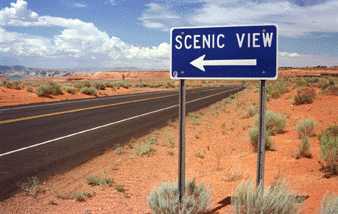
 |
A Visual Cultural Study of Snapshot Photography, Landscape, and Tourism in the Contemporary American West |
 |
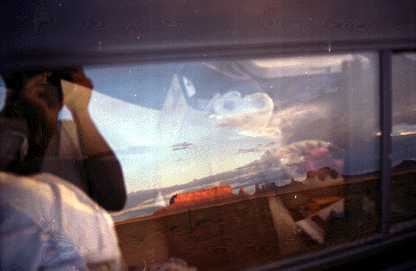
A reflection that occurs in the landscape in existing lakes or even in constructed reflecting pools shows us a "natural" representation of a framed landscape. As W. J. T. Mitchell argues, a reflection is attractive to the romantic landscape aesthetic because it is "a trace or icon of nature in nature itself [that] exhibits Nature representing itself to itself, displaying an identity of the Real and the Imaginary that certifies the reality of our own images." |
 |
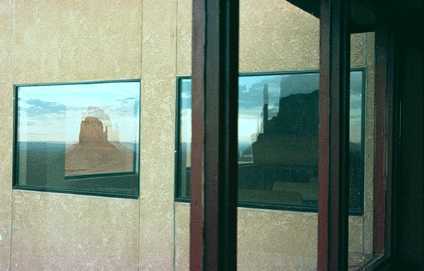 |
A photograph of Monument Valley reflected in a framed window refers not only to the landmasses themselves but also to the general cultural history of their framed representation in movies, landscape photography, and postcards. When my body is also reflected in that window, the photograph then also refers to a specific act of cultural representation made at a specific space in time by a specific person who is inseparable from the representation that is rendered. |
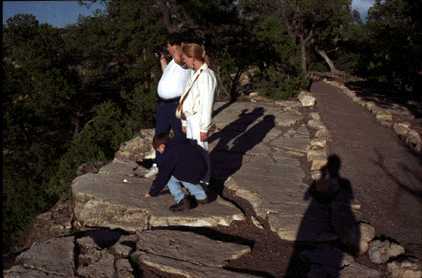
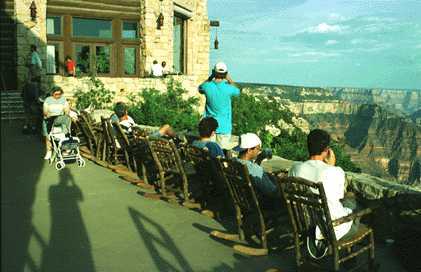 |
An image of the photographer in the act of photographing--in reflections, shadows, etc.--connects the subject matter of the photograph to the person who took the photograph. Thus we know that the photographer plays an important, if barely visible (only literally seen in traces such as reflected images, shadows, etc.) role in shaping this particular production of meanings. In this regard, it is important that we cannot see the photographer's full face in the window reflection--the camera eclipses her or his face, substituting a visual technology for the most distinctive representation of her or his subjectivity, the eyes. |
This focus on the photographer's vision or visual technology, however, does not obscure the fact that both a photographer and a person actually interacted with photographic subjects at a particular intersection of space and time. Not only does my use of framing, syntax, and use of text build connotations into the photographs, but also my physical presence in the scenes I photographed implicitly affected and effected the actual postures and poses of the figures I photographed, further affecting the connotations that the photographs contain |
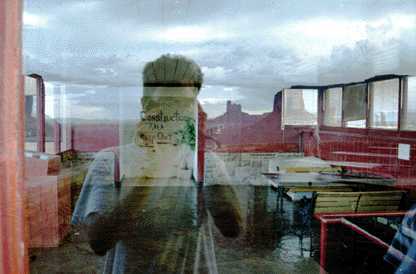 |
In my own case I can offer a partial answer. In my attempt to produce pictures of tourists "acting naturally," I tried to be as unobtrusive as possible when I took people's pictures at overlooks. Invariably, however, my "unnatural" attention to their "natural" actions frequently called attention to myself.
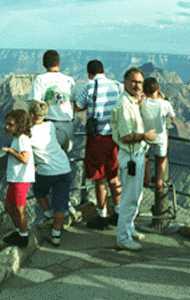 |
In most cases, my presence at the overlooks--especially at smaller and crowded ones--understandably made some of the people there act as if they were self-conscious about having their picture taken by a stranger.Often people who noticed me seemed to assume that they were obscuring my view of the landscape, so they would try to get out of my way. When I waved them off, telling them that they weren't in my way at all, they looked at me puzzled for a moment before returning to their activities. They usually kept a suspicious eye on me for the rest of the time they were at the overlook, however. If there was a party of people there with only one person taking the pictures, the people standing beside the photographer would often notice me and admonish their snapshooting companions for taking too long to take their pictures and violating the etiquette of appropriate overlook turn-taking. |
My photographs and my analysis are intended to have the same initial effect on my readers that my presence at overlooks seemed to have on my fellow tourists. But those effects need to be extended. Because I now have your eyes and ears for longer than I ever did with the tourists at the sites, I hope I that I am making my approach make more sense to you now than I could then to them.
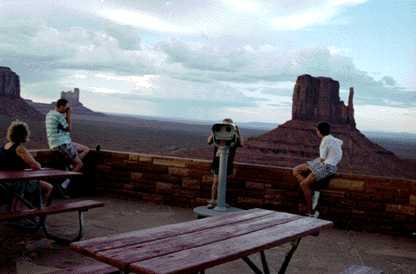
|
Design, Photography, and Text © 2001 by Bob Bednar
Department of Communication
snapshot semiotics home | overview | portfolio | shadows and reflections | caught looking | deconstructing nature/culture |
 |
A Visual Cultural Study of Snapshot Photography, Landscape, and Tourism in the Contemporary American West |
 |